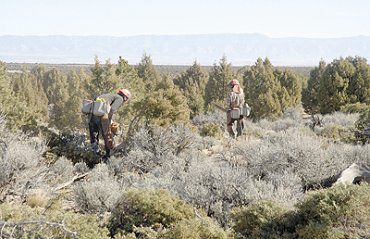Mule deer numbers have slowly been declining in the west since the times when our fathers and grandfathers hunted. There are many factors that have changed over the past 50 years such as: oil and gas development, grazing management, wildfire suppression, urban encroachment, invasive plants, and aspen and sagebrush decline to name a few. All of these factors that affect mule deer have one thing in common, a decline in habitat quality and quantity.
The amount of food for browsing ungulates, like mule deer, has declined due to a change in plant communities. Many areas that were once dominated by shrubs like sagebrush have been converted to pinyon/juniper forests. Pinyon/juniper forests slowly out-compete forage for mule deer and become a monoculture of trees with nothing growing in the understory.
Our rangelands have changed drastically over the last century. Desirable forage on summer and winter range has lost the ability to produce the same amount of food for deer and in some cases the desirable foods cannot grow due to competition with plants that deer do not eat. In a majority of Utah and the southeast region fawn/doe ratios are low, just enough to maintain a population. There are cases where fawn/doe ratios are high like, the Henry Mountains. The Henry Mountains had a very large fire in 2003, the fire burnt from the winter range to the summer range. After a couple of years the plant communities have recovered and nutrition is at a surplus for deer unlike before the fire. The deer herd was very low before the fire and it allowed the plants to recover without being over-browsed severely and inhibiting full recovery of the plants. The plants that came back were young, had more nutrition and the plants were bigger than old plants. This allows does to gain more weight, before and during pregnancy, allowing for bigger stronger fawns.
In the fall of 2012 Utah Division of Wildlife Resources hired a crew of chainsaw operators to cut 2,233 acres of pinyon and juniper trees north of Huntington in the Poison Springs Bench area, The area had re-grown with pinyon and juniper trees since the area had originally been chained or as some say railed many decades ago. There was still sagebrush, grasses and wildflowers growing within the trees. Since there was still a very good understory, UDWR decided that by cutting the pinyon and juniper trees out of these areas that deer and elk use during the winter the area would maintain and not lose any value to the animals that rely on this area for food and shelter in the winter months.
Mule deer thrive in early to mid-aged plant communities. Mother Nature used to do this on her own with wildfires, fire suppression over the past century has allowed for plant communities to become dominated by evergreen trees. Old/late plant communities, like a pure stand of pinyon and juniper trees with nothing growing within them have very little foraging value to deer. Tree removal, like chainsaw crews cutting pinyon and juniper trees for deer and elk, preserves an early plant community and allows for higher quality food for deer and elk to grow. This is why UDWR is spending time and money to try and maintain these areas for winter foraging.
While the Spirit of Conservation Pinyon/Juniper Removal Project might not restore mule deer populations in Emery County to levels seen in the 1960s, they will help sustain existing populations. With plant communities in Emery County trending towards higher pinyon/juniper content, and poor foraging opportunities, industry and wildlife managers must capitalize on opportunities to provide additional high quality forage. That is why UDWR and the Utah Watershed Restoration Initiative partnered with ConocoPhillips along with the National Fish and Wildlife Foundation who awarded UDWR the Spirit of Conservation Grant to remove portions of the monoculture of trees to maintain wintering forage areas for deer and elk. UDWR wants to thank ConocoPhillips for all of their contributions to wildlife habitat projects.
Habitat project for wildlife

"Workers cut pinyon and juniper trees with a chain saw to make room for sagebrush and other plants for wildlife."
